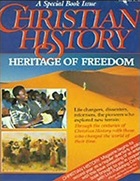In 1833 the English prime minister warned the country's bishops 'to set their house in order'. Though he did not complete the quotation from the Old Testament book of Kings, others did: 'for thou shall die'. A mob in Bristol burned down the bishop's residence, and Or Arnold, headmaster of Rugby School, wrote, 'the church as it now stands, no human power can save'. Some years earlier in London, only six people had attended Easter Communion in St Paul's Cathedral.
The Church of England was ripe for a new movement, and in 1833 she got it; the leaders were to be called - as well as other things less complimentary - Tractarians'.
Beginnings
In July 1833JohnKeble,a Fellow of Oriel College, Oxford, preached the annual assize sermon. He called it 'National Apostasy', and particularly attacked a Bill before parliament to make half the Irish bishops redundant. Those present can have had little idea that the sermon heralded a movement which was to have a revolutionary effect on church life in Britain.
Ten days after Ihe assize sermon, four men met at Hadleigh Rectory in Suffolk to make proposals for action. John Keble, undoubtedly the founder of what became known as the Oxford Movement, was not among them. But one of his disciples-Richard Froude - was. In the short time before his death three years later, Froude did something which was to be crucial in the development of the Movement. He converted a young Fellow of Oriel College from evangelical to high church views. His name was John Henry Newman, and he was to become the Oxford Movement's most famous leader, ultimately joining the Roman Catholic Church and becoming a cardinal.
The four who met at Hadleigh took an important decision: to issue some pamphlets which they called Tracts for the Times (hence the name Tractarians). These were anonymously-written, four-page leaflets and sold for a penny each. Newman cycled round the villages of Oxfordshire with bundles of these tracts, selling them wherever he could to the local clergy. An early member of the group was a young politician called William Gladstone, who later became one of Britain's finest prime ministers.
The Oxford Movement spread throughout Britain. For the first three years, it caused no apparent trouble. But the lull ended in 1836 and a storm of persecution began which was to last many years. The Tractarians were accused of popery and dubbed 'Puseyites' (after Edward Pusey, the noted Oxford academic who joined the group in 1834). This was untrue-at least in its early stages the Oxford Movement was anti-Catholic. The blurb on the first tracts professed them to be 'against Popery and dissent'. Dr Arnold led the first assault, to be followed by other leaders; the Bishop of Chester called the Movement 'a work of Satan'.
Newman's Tract 90, written in 1841, provoked a storm of abuse. In it he attempted to show that the Anglican Thirty-Nine Articles were not against the Roman Catholic Church and could be interpreted in a Catholic sense. At the same time, Newman himself began to have doubts about Anglican orthodoxy, and in 1842 he retired from all office in the Church of England. In 1845 he was received into 'the one Fold of Christ', as he called the Church of Rome.
A fresh start
To some, Newman's departure seemed to mark the end of the Oxford Movement; but instead it transformed it into a new power. Contrary to expectations, none of the other leaders followed suit.
The Movement had reflected far too much the views of Newman. Other men now became involved and its nerve-centre moved away from Oxford. Persecution continued, and Queen Victoria saw to it that no honours or promotion fell to the Tractarians. John Keble, the founder, died in 1866 without honours, although later he had an Oxford College named after him.
The Tractarians possessed superb leaders, men of saintliness as well as learning. In Newman, and later in Henry Liddon, they possessed two of the best preachers in Britain. Tractarian hymns (especially those by F. W. Faber, J. M. Neale and Newman himself) matched those of the Wesleys. Later in Sir Gilbert Scott and William Butterfield they produced architects; James Mozley and Edward Pusey were theologians of the highest calibre. They restored religious communities within the Anglican Church, renewed worship (they introduced choirs), emphasized the importance of holy communion and later pioneered social action. They were also the first to be concerned about conditions in the inner cities.
If it could be said that the evangelicals saved the Church of England at the end of the eighteenth century, the same could be claimed for the Tractarians in the nineteenth. They have left their mark permanently on the church scene.
Copyright © 1986 by the author or Christianity Today/Christian History magazine.
Click here for reprint information on Christian History.

Support Our Work
Subscribe to CT for less than $4.25/month




























